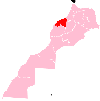Azemmour
Azemmour
Azmmur ⴰⵣⵎⵎⵓⵔ أزمور Azamor / Azemmour | |
|---|---|
Town | |
 Azemmour old city. | |
| Country | |
| Region | Casablanca-Settat |
| Province | El Jadida |
Azemmour or Azamor (from berber: Azmmur or Azemmur "The Olive" ; Portuguese: Azamor) is a Moroccan city, on the left bank of the Oum Er-Rbia River, 75 km southwest of Casablanca.[1]
History
Before 1486, it was a dependency of the King of Fez. In 1486 its inhabitants became vassals and tributaries of João II of Portugal.[2]
In 1513 Azemmour's governor Moulay Zayam refused to pay the tribute and mustered a powerful, well-equipped army. Manuel responded to this challenge by sending a massive fleet of 500 ships and 15 thousand soldiers (Bergreen, 19). James, Duke of Braganza led this army and on 1 September he conquered the city with no resistance from its inhabitants. Ferdinand Magellan, the man famed for leading the first-ever circumnavigation of the earth, was among the Portuguese soldiers there; he lost his horse in skirmishes outside the city.[3] Portuguese control of the city lasted only for a short period; it was abandoned by João III of Portugal in 1541 due to his court's economic difficulties.[4]
Geography
Azemmour is located on the Oum Er-Rbia River 75 kilometres (47 mi) west of Casablanca.[1]
Azemmour's beach, referred to locally as Azemmour Plage, is a place for surfing and kitesurfing.[5] Also called Haouzia, the area's flora includes eucalyptus and pine.[6]
Culture
A spring festival is held annually in Azemmour in March. It was first held in 2007.[7] The patron saint of Azemmour is Abu Shuayb. His mausoleum was built on the order of Mohammed ben Abdallah. Each year, a moussem is celebrated to honour him. The Old City's walls are decorated by several local artists.[8] The city features a Portuguese medina, which has three parts, a Jewish mellah, a kasbah, and the old medina.[1] A historic lighthouse called Sidi Boubeker is located 8 kilometres (5.0 mi) north of Azemmour.[6]
Notable natives or residents
- Estevanico, also known as Esteban the Moor, was enslaved and traveled with a Spanish expedition to North America in 1527. He is the first African to travel with explorers in North America and was one of four men out of several hundred to survive shipwrecks on the Florida and Texas coasts, Native American slavery and attacks, and other setbacks over a six-year period before he and his party reached safety in a Spanish colonial town.[1][9]
See also
Images
-
Azemmour old city.
-
Azemmour seen from Oum Er-Rbia River.
-
Synagogue.
-
Azemmour 16th century.
-
Street art at Azemmour.
References
- ^ a b c d Fodor's Travel Publications, Inc (2012). Fodor's Morocco. Fodors Travel Publications. p. 123. ISBN 978-0-307-92832-0.
- ^ Lhoussain Simour (19 November 2014). Recollecting History beyond Borders: Captives, Acrobats, Dancers and the Moroccan-American Narrative of Encounters. Cambridge Scholars Publishing. p. 55. ISBN 978-1-4438-7142-6.
- ^ EPUB 2-3 (23 October 2013). Ferdinand Magellan. Infobase Learning. ISBN 978-1-4381-4851-9.
{{cite book}}: CS1 maint: numeric names: authors list (link) - ^ Leonor Freire Costa; Pedro Lains; Susana Münch Miranda (3 May 2016). An Economic History of Portugal, 1143–2010. Cambridge University Press. p. 43. ISBN 978-1-107-03554-6.
- ^ "Azemmour Travel Guide - VirtualTourist". www.virtualtourist.com. Retrieved 21 October 2016.
- ^ a b DK (2 February 2015). DK Eyewitness Travel Guide Morocco. DK Publishing. p. 117. ISBN 978-1-4654-3832-4.
- ^ Marcello Balbo (15 May 2012). The Medina: Restoration and Conservation of Historic Islamic Cities. I.B.Tauris. p. 160. ISBN 978-1-84885-713-1.
- ^ Travel guide of Lonely Planet: Morocco, 9th Edition Feb 2009, ISBN 978-1-74104-971-8 p. 149.
- ^ Edward E. Curtis (2010). Encyclopedia of Muslim-American History. Infobase Publishing. p. 172. ISBN 978-1-4381-3040-8.







